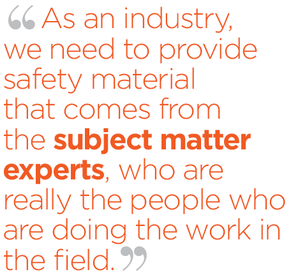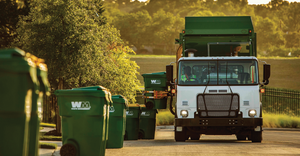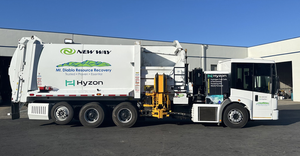NWRA Explores New Safety Strategies for Three-year Plan
The National Waste and Recycling Association (NWRA) recently named Anthony Hargis as its new national safety director, just in time for the association’s safety summit next week.
Hargis is a successful safety leader who has experience in the waste industry, compliance and training. He will help NWRA develop a safety culture for both the association and the waste and recycling industry as a whole.
“Part of our strategic plan for focus on safety is really to elevate our own competencies on safety, which is why Tony is here,” says NWRA President and CEO Sharon H. Kneiss. “We’re very excited about having him on board, and he has a lot of strong experience in the areas we need strong experience in. He knows safety, and he has a passion about it. We are just off the start line with Tony, and I think we are going to see a lot of benefits as a result of him being here.”
Waste360 recently spoke with Kneiss and Hargis about NWRA’s safety plan for the next three years and what they plan to discuss in the association’s upcoming safety summit.
Waste360: Can you tell us a little bit about your background and what experience you bring to this position?
 Anthony Hargis: I started my career in warehouse distribution and transportation, and then I started working as a driver for a regional carrier that hauls garbage from transfer stations to landfills. I was working up to 13 feet off the ground tarping trailers and walking on top of pretty much anything that anyone could throw in the garbage to be hauled to a landfill. I would work in adverse weather conditions, and I think the first month I worked there it rained for 30 days straight, so you can imagine the hazards there.
Anthony Hargis: I started my career in warehouse distribution and transportation, and then I started working as a driver for a regional carrier that hauls garbage from transfer stations to landfills. I was working up to 13 feet off the ground tarping trailers and walking on top of pretty much anything that anyone could throw in the garbage to be hauled to a landfill. I would work in adverse weather conditions, and I think the first month I worked there it rained for 30 days straight, so you can imagine the hazards there.
From a risk assessment perspective, I was scared to death when I first started off. It was really frightening to climb the trailers in the rain, but after a while you start to manage risk a lot differently than when you first started. You start to become comfortable in certain environments, and you start to take on more risks. When you get into that comfort zone, that’s where a lot of error occurs. In this industry, we have to identify risks and provide people with safety tools to avoid injury and error.
Waste360: As someone who started off in the industry, what do you feel are some of the problem areas when it comes to safety?
Anthony Hargis: This industry is incredibly risky, from working in different weather environments to the operating model workers are operating in residential communities to working inside landfills. The construction industry is suffering from a lot of the same issues we are, and we are both working around a lot of heavy equipment. Both industries also have a lot of unsupervised labor and employees who are asked to manage their own risk and determine what that risk is.
 Back when I was working in the industry, I used to have to go into work on a Saturday and listen to someone who doesn’t even work in the industry instruct workers on how to tarp trailers, drive trucks, handle the materials, etc. When I moved into operations and safety, one of the first things I did was take some drivers who were working on a regular basis and asked them to teach the safety classes. Once that happened, everyone started listening. As an industry, we need to provide safety material that comes from the subject matter experts, who are really the people who are doing the work in the field.
Back when I was working in the industry, I used to have to go into work on a Saturday and listen to someone who doesn’t even work in the industry instruct workers on how to tarp trailers, drive trucks, handle the materials, etc. When I moved into operations and safety, one of the first things I did was take some drivers who were working on a regular basis and asked them to teach the safety classes. Once that happened, everyone started listening. As an industry, we need to provide safety material that comes from the subject matter experts, who are really the people who are doing the work in the field.
Now, industry leaders have said the biggest epidemic in traffic safety is the distracted driving issue. This is definitely going to be a topic of conversation in our summit next week. We will seek out best practices from the companies that manage distracted driving in their environment and talk about how they go about training their drivers to acknowledge the distractions of the drivers who are operating around them.
Waste360: What are some of the ideas that NWRA is exploring for its new safety plan?
 Sharon H. Kneiss: We are working on creating a very comprehensive, strategic safety plan for the next three years. Our first strategic plan was from 2012 to 2015, and we held a meeting in August of last year to get feedback from members on what was working and where we needed to improve. We then started developing ideas for the 2016 to 2018 plan.
Sharon H. Kneiss: We are working on creating a very comprehensive, strategic safety plan for the next three years. Our first strategic plan was from 2012 to 2015, and we held a meeting in August of last year to get feedback from members on what was working and where we needed to improve. We then started developing ideas for the 2016 to 2018 plan.
We actually have about five strategic initiatives at NWRA, and one of them is a strong focus on safety. Safety is a critical issue for this industry, and our industry record on the collections side needs to be significantly approved.
We have a safety committee made up of about 40 members from both large and small companies who will also help guide our efforts going forward. This year, we wanted to make sure that as we were developing this plan that we brought the right people to the table, from both inside the industry and outside the industry.
We took a look at where we needed to be in safety in the next three years, and we have stepped up our efforts to put out best practices on both post collection facilities and safety. In January, we hosted a week-long Safety Stand Down on backing, where companies were given the opportunity to participate in risk reviews and analysis. We received great feedback on this and will hold other Stand Downs in May and September of this year.
The association will also create tools, resources and educational products for the members to help them develop their safety efforts. We are considering podcasts, two- to three-minute videos, mobile apps and other effective outlets that are easy to access. In addition to that, we are also looking at collaborating with AT&T to piggyback off their distracted driving problem to make a greater impact.
Once we create the safety program, we will develop both leading and lagging indicators. I anticipate that it will be about two to three years before we will start to see a diminution in incidents and fatalities.
About the Author
You May Also Like




